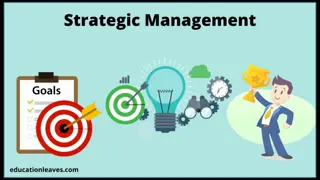Strategic Role of Human Resources in Achieving Business Goals
Strategic human resource management is vital in aligning employee skills and behaviors with business objectives. By developing effective management policies, HR ensures that the workforce is equipped to drive the company towards its strategic goals within a dynamic market environment. The focus lies on managing employee relationships, fostering competence, flexibility, and productivity, and facilitating effective communication and training practices.
Download Presentation

Please find below an Image/Link to download the presentation.
The content on the website is provided AS IS for your information and personal use only. It may not be sold, licensed, or shared on other websites without obtaining consent from the author. Download presentation by click this link. If you encounter any issues during the download, it is possible that the publisher has removed the file from their server.
E N D
Presentation Transcript
Human Resources Role
Strategic role of human resources Strategic management is all about moving a business from its current position in the market place to the vision of the sort of business its managers want it to be in, say, five years time. This is the role of the top management team. This team establishes strategic goals that might include things like improving market share from, say, 12% to 15% over the next five years. The human resource manager can have an important role in developing the strategic plan because businesses achieve their goals through the people they employ.
Once the strategic goals have been determined, the next step is to identify the employee skills, attributes and behavioursthat will be required to achieve the goals. For example, when retailers, such as Coles, decide on the strategic goal of improving market share, one of the main strategies to achieve that goal is high levels of customer service. The ability to deliver high levels of customer service is the employee skill required to achieve the goal.
Strategic human resource management is concerned with developing management policies that will deliver the employee skills and behaviours required to achieve the goals. In our previous retail example one of the most obvious policies will be concerned with training employees to deliver high levels of customer service. You know, from your own experiences in retail shops, that some businesses do this a lot better than others. Those that do tend to have carefully developed management policies. The strategic role of human resource management is to provide the business with the people who have the skills, attributes and behaviours the business will require if it is to achieve its strategic goals in a dynamic and often turbulent environment.
Human resources aims to manage the relationship between employer and employees effectively in order to develop competent, flexible, productive employees committed to the organization. Identify and select competent employees and maintain a high level of performance over the long term. Develop strategies to ensure effective communication with employees Ensure employees are appropriately and adequately rewarded Provide the necessary training and development Develop strategies to provide the flexible working conditions of human resources
Interdependence with other key business functions
Outsourcing Outsourcing of the human resource functions was very popular during the 1980s and 1990s. Outsourcing means that many of the traditional human resource functions, such as recruiting, were provided by other specialist human resource businesses. At the time it was considered that this was not only cost-effective but also the best way to get the best talent. It was considered cost-effective because permanent specialist human resource employees would not be required and effective because people could be recruited from anywhere in the world.
Human resource functions Before we consider the way human resource functions are outsourced, it might be helpful to recall, from the unit in the preliminary course, the nature of the human resource function. Typically, the human resource function starts with job analysis. Job analysis is concerned with working out what tasks need to be done if the business is to achieve its objectives and the skills needed to do those tasks. The next task is to recruit and select the people best able to do those tasks. Training and development are also important.
There are also quite a few functions that are less obvious. These include establishing grievance procedures, monitoring Occupational Health and Safety (OH&S) issues, Equal Employment Opportunity (EEO) issues and, most importantly, planning for the development of a business culture that embraces change. In some businesses, some of the traditional human resource functions have been passed over to the operations function. Many operations managers, for example, are responsible for things like recruitment, training and OH&S. In other instances some of the human resource functions have been outsourced.
Recruiting is concerned with getting a number of qualified people to apply for a job so that the best applicant can be selected. Currently, many large businesses get outside employment agencies to conduct the recruiting for temporary staff and jobs that do not require costly training and can generally be performed with a lower level of skill.
Employee attributes are the single most important criteria when recruiting people for many types of jobs. Skills can be taught but it is very difficult to change attitudes. In-house recruitment is more likely to select employees with the attributes needed to achieve specific business goals than an external employment agency.
The main focus of current human resource management is to outsource any function that improves efficiency and cuts costs. However, large businesses doing this sort of outsourcing are very careful to keep in-house any human resource activity that requires understanding the business and its customers, identifying future leaders and promoting change.
Using contractors - domestic, global Domestic Independent contractors exist in a situation where an individual s employment by one employer is not ongoing and an agreed fee is paid for the service. There has been a rapid growth in independent contractors, such as labourhire companies. Benefits and risks in contracting range from lower costs, to the problem of loss of direct customer contact, and consistent quality and performance in outsourced activities.
Global Given the global nature of businesses today, many Australian organisations access foreign labourresources. Using foreign businesses to provide a readymade workforce allows the Australian business to access the use of labour, without having to consider such issues as minimum labourrequirements, occupational health and safety laws, and termination. This does pose a number of ethical issues.























